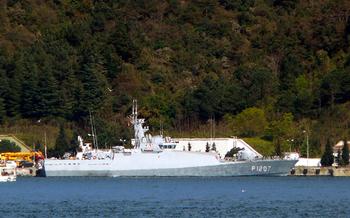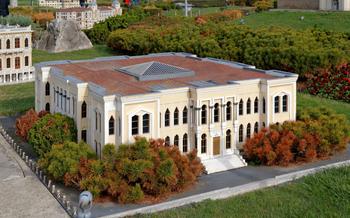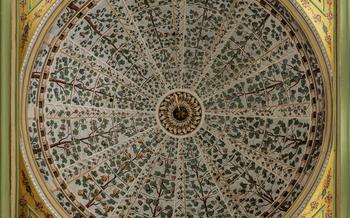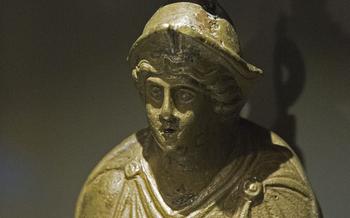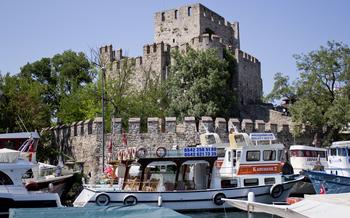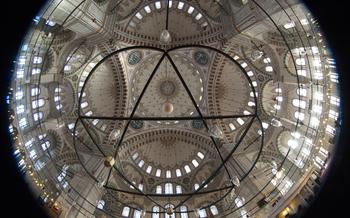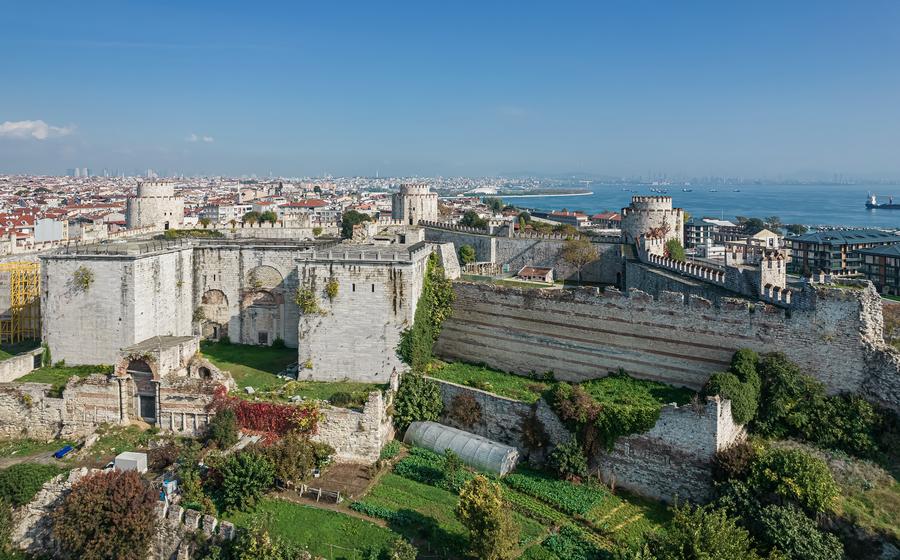
Yedikule Fortress
- Yedikule Fortress: A Symbol of Istanbul's Resilience
- Delving into the History of Yedikule Fortress
- Exploring the Architectural Marvels of Yedikule Fortress
- Unveiling the Cultural Significance of Yedikule Fortress
- Must-See Highlights within Yedikule Fortress
- Exploring the Surrounding Area of Yedikule Fortress
- Historical Context: The Byzantine and Ottoman Empires
- The Role of Yedikule Fortress in Istanbul's Defense
- Legends and Myths Surrounding Yedikule Fortress
- Yedikule Fortress as a Museum and Cultural Center
- Preservation and Conservation Efforts
- Yedikule Fortress in Popular Culture
- Insider Tip: Hidden Gems and Secret Spots
Yedikule Fortress: A Symbol of Istanbul's Resilience
Yedikule Fortress stands as a testament to Istanbul's rich and resilient history. Constructed in the 5th century by the Byzantine Emperor Theodosius II, it served as a vital stronghold for the empire, protecting the city from invaders. In the 15th century, the fortress played a crucial role in the Ottoman conquest of Istanbul, as it was one of the last Byzantine strongholds to fall. During the Ottoman period, the fortress served as a prison and treasury, housing famous prisoners and safeguarding the empire's wealth. Today, Yedikule Fortress stands as a symbol of Istanbul's resilience, having withstood centuries of sieges, earthquakes, and political turmoil. It is a must-visit destination for anyone interested in exploring Istanbul's fascinating past.
Anecdote:
I remember my first visit to Yedikule Fortress vividly. As I walked through its imposing gates, I couldn't help but feel a sense of awe at its size and grandeur. I spent hours exploring the fortress's many towers, chambers, and dungeons, each with its own unique story to tell. One of the most memorable moments was when I stumbled upon a small, hidden chamber that was once used as a prison cell. The walls were covered in graffiti, left by prisoners who had been held captive within its walls. It was a sobering reminder of the fortress's dark past, but also a testament to the resilience of the human spirit.
Delving into the History of Yedikule Fortress
Yedikule Fortress, a formidable symbol of Istanbul's rich past, traces its origins back to the Byzantine Empire in the 5th century. Initially constructed as a citadel to guard the city's land walls, it played a crucial role in defending Constantinople against invading forces. During the Ottoman conquest of Istanbul in 1453, the fortress witnessed fierce battles and eventually fell to the Ottoman army, marking a significant turning point in the city's history.
Under Ottoman rule, Yedikule Fortress served various purposes. It functioned as a prison, housing prominent figures such as captured rulers and high-ranking officials who fell out of favor with the sultan. The fortress's dungeons and chambers echoed with the cries of political prisoners and dissidents who languished within its walls. Additionally, the fortress served as the treasury, safeguarding the empire's vast wealth and precious artifacts.
One of the most intriguing tales associated with the fortress is the story of Prince Cem Sultan, the younger brother of Sultan Bayezid II. Cem Sultan, a claimant to the Ottoman throne, was imprisoned in Yedikule Fortress for over eight years. During his captivity, he attempted to escape several times, leading to dramatic events that unfolded within the fortress's walls.
Exploring the Architectural Marvels of Yedikule Fortress
Yedikule Fortress showcases an impressive array of architectural marvels that reflect its rich history and strategic significance. Its most distinctive feature is the seven towers, each with unique characteristics and a fascinating story to tell. The First Tower, known as the Bloody Tower, served as a prison and execution ground, while the Second Tower housed the imperial treasury and archives. The Third Tower features a cistern and a secret passageway leading to the Golden Horn. The Fourth Tower, also known as the Tower of Honor, served as a residence for high-ranking prisoners. The Fifth Tower, known as the Tower of Hope, was used for solitary confinement and is said to have been the site of many executions. The Sixth Tower, known as the Tower of Faith, was used as a prison for political prisoners, while the Seventh Tower, known as the Tower of Love, was reserved for female prisoners.
In addition to its towers, the fortress boasts impressive walls and gates that showcase intricate craftsmanship. The walls, which are up to 12 meters thick in some places, are reinforced with towers and bastions, creating a formidable defensive structure. The main gate, known as the Golden Gate, is a masterpiece of Byzantine architecture, featuring intricate carvings and reliefs that depict scenes from the Bible. The fortress also contains hidden dungeons and chambers that offer a glimpse into its dark and mysterious past. These hidden spaces were used to store treasure, hold prisoners, and carry out executions, adding to the fortress's aura of intrigue and mystery.
Unveiling the Cultural Significance of Yedikule Fortress
Yedikule Fortress holds immense cultural significance, recognized not only in Turkey but also on a global scale. In 1985, UNESCO bestowed upon the fortress the prestigious title of a World Heritage Site, solidifying its status as a treasured landmark of outstanding universal value. This designation serves as a testament to the fortress's exceptional architectural and historical importance, recognizing its role as a symbol of Istanbul's enduring resilience throughout the ages.
The fortress is also home to a captivating museum that invites visitors to delve into its rich past. Through a series of captivating exhibits and displays, the museum brings to life the stories of the fortress's former inhabitants, from Byzantine emperors to Ottoman sultans. Visitors can admire artifacts that span centuries, gaining insights into the fortress's diverse cultural heritage and the significant events that have transpired within its walls.
In addition to its museum, Yedikule Fortress often hosts cultural events and exhibitions that celebrate Istanbul's vibrant artistic traditions. These events provide a platform for local and international artists to showcase their work, creating a dynamic and engaging cultural space within the fortress's historic setting.
Anecdote:
During my visit to Yedikule Fortress, I had the privilege of attending a traditional Turkish music concert held within the fortress's courtyard. The enchanting melodies and rhythmic beats filled the air as talented musicians played traditional instruments, creating a magical atmosphere that transported me back in time. The concert not only showcased the fortress's cultural significance but also provided a unique and immersive experience for visitors like myself.
Must-See Highlights within Yedikule Fortress
Yedikule Fortress is a treasure trove of historical wonders, and there are several must-see highlights that visitors should not miss. The Golden Gate, the fortress's monumental main entrance, is a sight to behold with its intricate carvings and inscriptions. Explore the remains of the Church of St. Mary of the Mongols, a Byzantine church that offers a glimpse into the fortress's religious past. The Bloody Well, a chilling reminder of the fortress's dark history, is said to be the site where prisoners were executed.
Anecdote:
During my visit to Yedikule Fortress, I was particularly fascinated by the legend of the Golden Horn Treasure. It is said that a vast treasure, including gold, jewels, and precious artifacts, is hidden somewhere within the fortress's walls. While the treasure's existence remains a mystery, the legend adds an air of intrigue and excitement to the fortress's allure.
Exploring the Surrounding Area of Yedikule Fortress
Venturing beyond the fortress walls, you'll find yourself in the captivating Yedikule neighborhood, a treasure trove of historical charm. Stroll along its cobblestone streets and admire the preserved Ottoman-era houses, each with its unique character. Discover hidden gems like antique shops, traditional cafes, and artisan workshops, immersing yourself in the authentic atmosphere of this vibrant district.
As you make your way towards the Marmara Sea, breathtaking views await. From the fortress's ramparts, gaze upon the shimmering waters of the sea, where sailboats glide gracefully and the horizon stretches endlessly. Capture the essence of Istanbul's maritime heritage as you witness the captivating interplay of sea and sky.
Enrich your visit by exploring nearby attractions that complement the fortress experience. Delve into the world of contemporary art at the Feshane Art Center, housed in a former gunpowder factory. Alternatively, journey through the annals of history at the Istanbul Archaeological Museums, home to an impressive collection of artifacts from Turkey's rich past.
Indulge in the local culinary delights by seeking out the neighborhood's culinary gems. Savor the flavors of traditional Turkish cuisine at one of the many charming restaurants, where the aromas of freshly baked bread, grilled meats, and aromatic spices fill the air. As you savor your meal, engage in conversations with the friendly locals, who are always eager to share stories and insights about their beloved neighborhood.
Historical Context: The Byzantine and Ottoman Empires
Yedikule Fortress stands as a testament to the rich history of Istanbul, having played a significant role during the Byzantine and Ottoman Empires. The Byzantine Empire, ruling over the city for more than a millennium, left an indelible mark on its architecture, culture, and identity. The Ottomans, who conquered Istanbul in 1453, transformed it into the capital of their vast empire, leaving a lasting legacy that continues to shape the city today.
The Byzantine Empire, with its capital in Constantinople (present-day Istanbul), emerged as a powerful force in the Eastern Roman Empire. During their reign, they constructed magnificent churches, palaces, and fortifications, including the original foundations of Yedikule Fortress. The Byzantine Empire's strategic location at the crossroads of Europe and Asia made it a center of trade, culture, and learning.
The rise of the Ottoman Empire in the 13th century marked a new chapter in Istanbul's history. The Ottomans, led by ambitious sultans, expanded their territories across the Middle East, North Africa, and Eastern Europe. In 1453, Sultan Mehmed II, also known as Mehmed the Conqueror, laid siege to Constantinople and eventually breached the city's defenses, bringing an end to the Byzantine Empire.
The conquest of Constantinople marked a turning point in the history of the region. The city, renamed Istanbul, became the capital of the Ottoman Empire and a vibrant center of Islamic culture and architecture. The Ottomans transformed the Hagia Sophia, a magnificent Byzantine church, into a mosque, symbolizing their triumph and the blending of two great civilizations.
The siege of Constantinople in 1453 stands as a pivotal event in world history. The Ottomans, under the command of Sultan Mehmed II, deployed a massive army and a formidable fleet, determined to capture the city. The Byzantines, led by Emperor Constantine XI, fought valiantly but were ultimately overwhelmed by the sheer force of the Ottoman onslaught. The fall of Constantinople marked the end of the Byzantine Empire and the beginning of a new era under Ottoman rule.
The Role of Yedikule Fortress in Istanbul's Defense
Yedikule Fortress played a crucial role in defending Istanbul against various sieges and attacks throughout history. Its strategic location at the entrance to the Golden Horn made it a vital fortification for the city. The fortress's impressive fortifications, including its thick walls, towers, and gates, made it a formidable obstacle for any invading force.
During the Byzantine period, the fortress helped to protect the city from attacks by the Arabs, Bulgarians, and other enemies. In 1204, the fortress was captured by the Crusaders during the Fourth Crusade, but it was retaken by the Byzantines in 126
After the Ottoman conquest of Istanbul in 1453, the fortress continued to be used as a defensive structure. It played a key role in repelling attacks by the Hungarians, Venetians, and other European powers. The fortress's guns were also used to defend the city against naval attacks from the Black Sea.
One of the most famous sieges of Yedikule Fortress took place in 1571, when the Ottoman navy was defeated by the Holy League at the Battle of Lepanto. The fortress was besieged by the Holy League fleet, but it held out for several months before the Ottomans were able to lift the siege.
Yedikule Fortress remained an important defensive structure for Istanbul until the 19th century, when it was gradually replaced by more modern fortifications. Today, the fortress serves as a museum and cultural center, but it remains a reminder of the city's rich and tumultuous history.
Anecdote:
During the siege of 1571, the fortress's commander, Uluç Ali Pasha, is said to have displayed great courage and leadership. He led the fortress's defenders in a spirited resistance against the Holy League fleet, and he refused to surrender even when the odds were stacked against him. Uluç Ali Pasha's bravery and determination helped to ensure that the fortress remained in Ottoman hands, and he is still remembered as one of the fortress's greatest heroes.
Legends and Myths Surrounding Yedikule Fortress
Yedikule Fortress is shrouded in a veil of mystery and intrigue, inspiring numerous legends and myths that have captured the imagination of storytellers and historians alike. One of the most famous legends is the Seven Heads Legend. According to this tale, seven heads were buried beneath the fortress's towers to protect the city from invaders. Each head is said to represent a different enemy of the Byzantine Empire, including the Persians, Arabs, and Crusaders.
Another captivating legend is the Golden Horn Treasure. It is said that a vast treasure of gold and jewels is hidden somewhere within the fortress, buried by the Byzantine emperor Constantine XI Palaiologos before the fall of Constantinople to the Ottomans. Many have searched for this treasure, but none have ever succeeded in finding it.
The fortress is also haunted by the Ghost of the Janissary. This spectral figure is said to be the spirit of a janissary who was unjustly executed within the fortress's walls. He is said to roam the grounds at night, seeking revenge for his untimely demise.
These legends and myths add an air of enchantment to Yedikule Fortress, captivating visitors with their tales of hidden treasures, ancient curses, and restless spirits. Whether you believe in them or not, they are an integral part of the fortress's rich history and cultural significance.
Yedikule Fortress as a Museum and Cultural Center
Yedikule Fortress has undergone a remarkable transformation from a notorious prison to a vibrant museum and cultural center. In the early 20th century, the fortress was repurposed as a museum, recognizing its immense historical and cultural significance. Today, it houses various exhibitions and displays that showcase the fortress's rich history, architectural marvels, and cultural heritage. Visitors can explore exhibits on the fortress's Byzantine and Ottoman past, its role as a prison and treasury, and its architectural features.
The museum also organizes educational programs and workshops to promote cultural awareness and understanding. These programs provide visitors with an opportunity to delve deeper into the fortress's history, architecture, and cultural significance. Through interactive exhibits, guided tours, and hands-on activities, visitors can gain a comprehensive understanding of this iconic landmark.
Anecdote:
During my visit to the museum, I had the opportunity to participate in a guided tour led by a passionate historian. The tour brought the fortress's history to life as we explored its dungeons, chambers, and towers. The historian shared fascinating stories about the prisoners who were held within these walls, the executions that took place, and the fortress's role in defending Istanbul. It was an unforgettable experience that allowed me to connect with the fortress's past in a meaningful way.
Preservation and Conservation Efforts
Yedikule Fortress stands as a testament to Istanbul's rich history and cultural heritage. Preserving and conserving this iconic landmark is of utmost importance to ensure its legacy endures for generations to come. The fortress has faced various challenges over the years, including environmental factors, tourism, and urban development.
Restoration and conservation projects have been undertaken to protect and preserve the fortress's structural integrity and historical authenticity. These projects involve meticulous restoration work on the fortress's walls, towers, and gates, using traditional techniques and materials to maintain its original character.
One of the most significant preservation initiatives was the restoration of the fortress's Golden Gate, which serves as the main entrance. The gate underwent extensive repairs, including the reconstruction of its intricate carvings and the restoration of its original colors. The result is a stunning gateway that welcomes visitors with its grandeur and historical charm.
Another important conservation project focused on the fortress's dungeons and chambers. These hidden spaces were meticulously restored to reveal their original features, including the graffiti left by prisoners on the walls. Visitors can now explore these atmospheric chambers and gain a deeper understanding of the fortress's past as a prison.
The ongoing preservation and conservation efforts at Yedikule Fortress are a testament to the commitment to preserving Istanbul's cultural heritage. By safeguarding this iconic landmark, future generations will continue to appreciate its historical significance and architectural beauty.
Yedikule Fortress in Popular Culture
Yedikule Fortress has captured the imagination of artists, writers, and filmmakers for centuries. In literature, the fortress has been featured in novels, poems, and short stories by renowned Turkish and international authors. One notable example is the novel "The Forty Rules of Love" by Elif Shafak, which weaves a tale of love and mysticism set against the backdrop of the fortress.
In the world of cinema and television, Yedikule Fortress has served as a dramatic setting for historical dramas, thrillers, and even comedies. One of the most famous films to feature the fortress is "Topkapi," a 1964 heist movie starring Melina Mercouri and Maximilian Schell. The film follows a group of thieves as they attempt to steal a priceless dagger from the fortress's treasury.
Yedikule Fortress has also found its way into the realm of music and folklore. Turkish folk songs and ballads often mention the fortress, weaving tales of love, loss, and heroism. The fortress's imposing presence and rich history have inspired countless artists to create works that capture its essence and significance.
Anecdote:
During my visit to Yedikule Fortress, I stumbled upon a group of musicians performing traditional Turkish music in one of the fortress's courtyards. The haunting melodies and rhythmic beats transported me back in time, as if I had stepped into a scene from a historical drama. It was a magical moment that reminded me of the fortress's enduring legacy and its ability to inspire artistic expression.
Insider Tip: Hidden Gems and Secret Spots
Yedikule Fortress is a treasure trove of hidden gems and secret spots waiting to be discovered by curious explorers. Rumored to possess a network of hidden passageways and secret chambers, the fortress offers a thrilling opportunity to uncover its hidden depths. For those seeking breathtaking vistas, the ramparts of the fortress provide panoramic views of Istanbul and the shimmering waters of the Marmara Sea, creating a picturesque backdrop for unforgettable moments. To fully immerse yourself in the fortress's enigmatic allure, venture off the beaten path and explore its lesser-known corners. You might stumble upon forgotten relics, ancient inscriptions, or tranquil hidden gardens that will leave you with a lasting sense of wonder.

